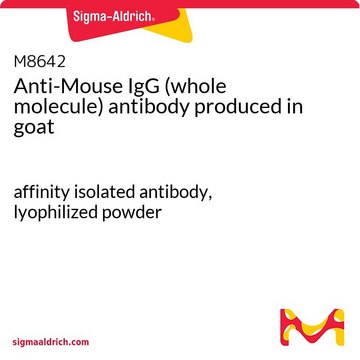76085
Anti-Mouse IgG - Atto 594 antibody produced in goat
~1 mg/mL protein, affinity isolated antibody
Sinónimos:
Atto 594 - goat-Anti-mouse IgG
About This Item
Productos recomendados
origen biológico
goat
conjugado
Atto 594 conjugate
forma del anticuerpo
affinity isolated antibody
tipo de anticuerpo
secondary antibodies
clon
polyclonal
contiene
50% glycerol as stabilizer
reactividad de especies
mouse
concentración
~1 mg/mL protein
fluorescencia
λex 603 nm; λem 625 nm in PBS
Condiciones de envío
wet ice
temp. de almacenamiento
−20°C
modificación del objetivo postraduccional
unmodified
Descripción general
Affinity isolated antigen specific antibody is purified from goat anti-mouse IgG antiserum to remove essentially all goat serum proteins, including immunoglobulin. Goat anti-mouse IgG associates with mouse IgGs.
Inmunógeno
Aplicación
Nota de análisis
Información legal
Cláusula de descargo de responsabilidad
¿No encuentra el producto adecuado?
Pruebe nuestro Herramienta de selección de productos.
Código de clase de almacenamiento
10 - Combustible liquids
Clase de riesgo para el agua (WGK)
WGK 1
Punto de inflamabilidad (°F)
Not applicable
Punto de inflamabilidad (°C)
Not applicable
Equipo de protección personal
Eyeshields, Gloves
Certificados de análisis (COA)
Busque Certificados de análisis (COA) introduciendo el número de lote del producto. Los números de lote se encuentran en la etiqueta del producto después de las palabras «Lot» o «Batch»
¿Ya tiene este producto?
Encuentre la documentación para los productos que ha comprado recientemente en la Biblioteca de documentos.
Los clientes también vieron
Artículos
Fluorescent Multiplex Detection using Antibody Atto Dye Conjugates
Nuestro equipo de científicos tiene experiencia en todas las áreas de investigación: Ciencias de la vida, Ciencia de los materiales, Síntesis química, Cromatografía, Analítica y muchas otras.
Póngase en contacto con el Servicio técnico









